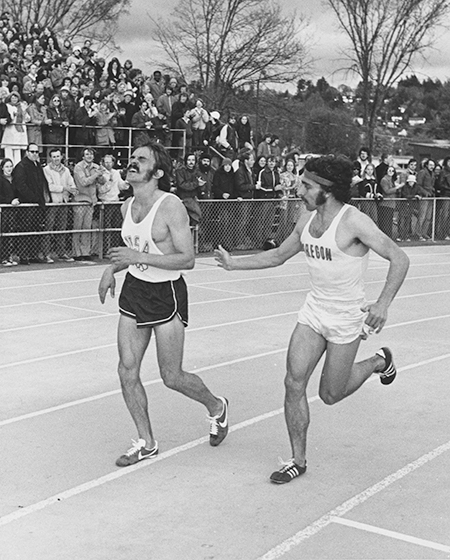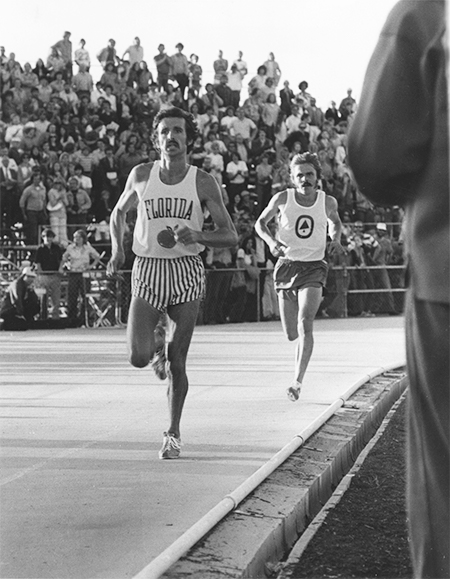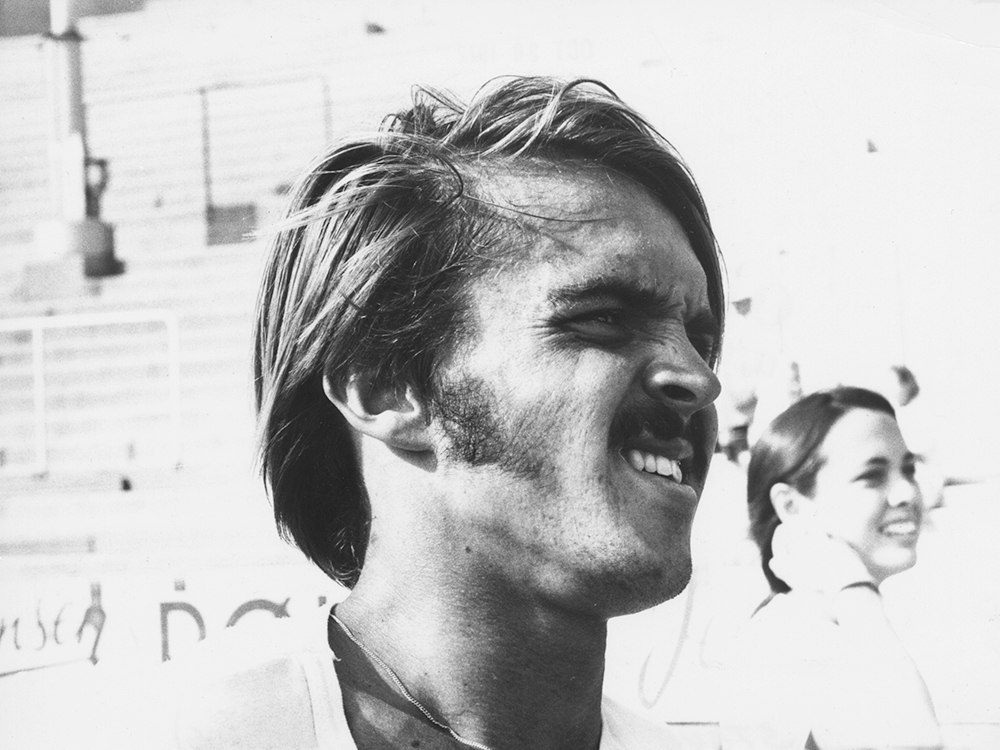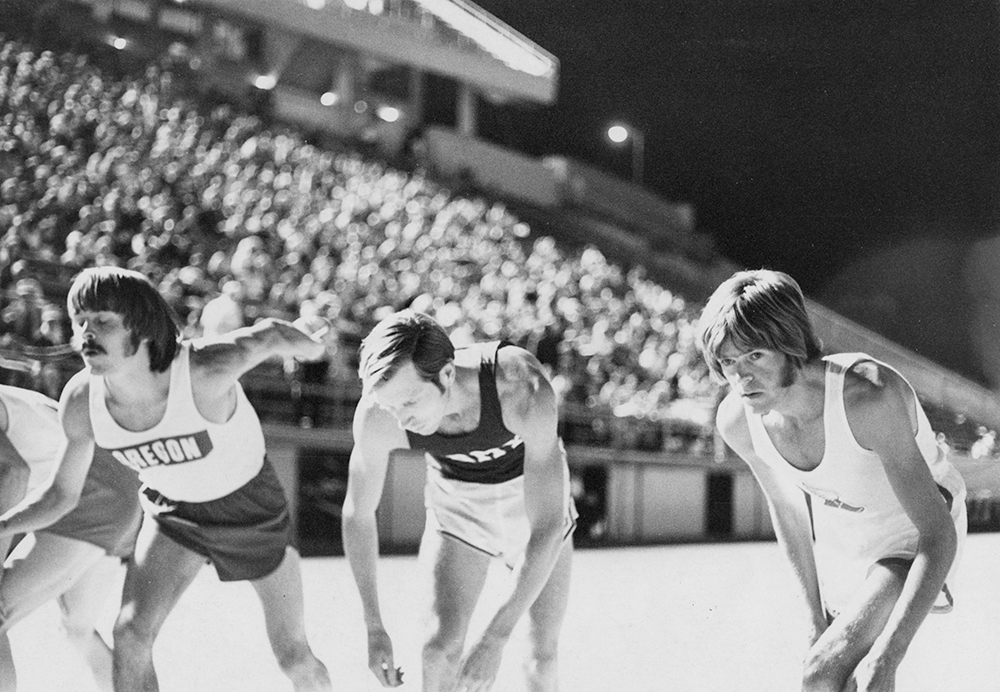HERE, IN THE 15th chapter of a long multi-part series, is how we reported the outdoor competition of Steve Prefontaine’s first year outside the collegiate ranks (a “pro,” as it were). We have taken the liberty of doing some stylistic updatings to mirror our modern protocol and also added an editorial comment or three.

II May 1974: “I’m Ready,” Says Pre—2 ARs
Eugene. Oregon, April 27—A big step toward making ’74 “The Year of Europe” was taken by Steve Prefontaine here as he gave 7000 spectators two records for the price of one at the annual Oregon Twilight meet.
Originally scheduled as a 6M, the race was boosted up to 10,000m on Prefontaine’s request. He responded with two American Records—26:51.8 and 27:43.6.
Prior to the meet Pre indicated that he thought these longer distances would be appropriate for his condition at this stage: “I haven’t done the quality work to run a good mile.” Pre has been gearing his training to a long summer in Europe and was pleased with the results here.
“I’ll start concentrating on some World Records now,” the unabashed Oregon TC runner said. “I think this indicates I’m ready.”
Pre preferred to stretch out to 10 kilos and did most of the work himself. Mike Manley led Steve after the first quarter and paced him through the first mile of 4:26. But Pre retook the lead after 5 laps and set off on his lonely chore—hitting 8:54, 13:24, 17:52, 22:22 and lowered his own U.S. 6M mark (27:09.4) to become history’s No. 3 performer while marking the No. 4 performance of 26:51.8. But there was still nearly a lap left in the race.
“I could have gotten the 6M World Record today if I would have sprinted the last lap of it,” Pre confided. A look at ‘his quarter splits verifies his point. The final quarter of the 6M was 65.8 and of the 10K was about 58. So that 7-second differential would have theoretically placed him at least 2 seconds faster than Ron Clarke’s 26:47.0 world mark.
So when he had completed 6M, plus 376.11 yards, Prefontaine had become No. 6 on the 10,000 performer and performance charts. He erased Frank Shorter’s 27:51.4 from Munich.
“I’ve increased my mileage up to 140 miles a week,” the 23-year-old added, “and I still think I can run 3M with anybody in the world, including Paul Geis. I needed this one to compare with the Europeans. Now I’m shooting for bigger things.”
II May 1974: Pre Rises On Triplers List
If Steve Prefontaine can run a 3:52.6 mile, or 12:47.0 for 3, or 26:28.4 for 6, he will be the greatest distance tripler in the world, at least according to the Portuguese Tables. Pre’s recent romp over 6M/10,000m catapulted him into the runner-up spot on the all-time list behind Belgian great Emiel Puttemans. Those who have reached the 3000-point level (y = yard mark):
3071 Emiel Puttemans (Belgium) 3:56.0y, 13:13.0, 27:39.6
3058 Steve Prefontaine (US) 3:54.6y, 13:22.4, 27:43.6
3044 Kip Keino (Kenya) 3:34.9, 13:24.2, 28:06.4
3033 Ron Clarke (Australia) 4:00.2y, 13:16.6, 27:39.4
3021 Dave Bedford (Great Britain) 4:02.9y, 13:17.2, 27:30.8
3021 Lasse Viren (Finland) 3:43.6, 13:16.4, 27:38.4
3012 Jürgen Haase (East Germany) 3:39.1, 13:29.4, 27:53.4
3005 Ian Stewart (Great Britain) 3:57.3y, 13:22.8, 28:17.2
[Ed: at this point in history the Portuguese Tables were the gold standard in comparing marks across events.]
II May 1974: U.S. SCENE
“I get the idea a lot of people think I died,” says Steve Prefontaine. “Sometimes people will come up to me and ask me what I’m doing now. I’m really excited about getting to Europe healthy and fresh this summer. Most Americans are getting ready for the AAU. I want to peak in late June and July. When I run a race this year I want to be ready for it.”
[Ed: As it turned out, Pre skipped the AAU, as explained in the next item.]
II June 1974: No AAU For Prefontaine
“I’m not going to run in the AAU championships.” Thus Steve Prefontaine threw down the gauntlet to the AAU and its international-competition moratorium.
“I’m going to compete all through their moratorium,” continued Pre, “and if they want to take me to court, that’s fine with me. I can take them for all they’re worth.
“What does it prove running in the AAU meet? The AAU doesn’t care about the athletes: why should I care about them? I’ll find meets to run in in Europe.”
Statements by Pre and Paul Geis that they would not compete in the US-USSR meet drew fire from meet director LeRoy Walker: “What I object to is their choice of
subterfuge. They talk about the track, the weather and crowd as reasons for not running. Well, I’ve seen competition both in this country and Europe that is run under worse conditions. Personally, I’m tired of these guys giving us all that flak and blaming it on the AAU–NCAA fight.”

I July: Prefontaine Claims American 3M Record
Eugene, Oregon, June 08—[Ed: For once the major headlines for a Eugene competition, this one the Hayward Restoration Meet, went to Rick Wohlhuter, who set a WR 1:44.1 in the 880.]
…Lining up head-to-head [in the 3M] were Steve Prefontaine, the hometown hero, and Frank Shorter, the Olympic hero.
“I’ve had the flu, a cold, the whole bit during the past couple of weeks,” the talkative Prefontaine said before the meet. “I haven’t had a decent workout in about three weeks, and that may affect my confidence.”
It was an unusual observation for a runner whose career has been known for occasional cockiness. So he and Shorter worked out a deal: “After the first mile, we were supposed to alternate the lead.” The desired 64-second pace, which would put them on World Record course, went slightly astray during the first mile, 4:16.5.
“I felt capable of breaking the American Record,” Prefontaine pointed out. He had cut down slightly on his workouts in order to give one last effort before heading to Europe for 6 weeks.
The Shorter/Prefontaine agreement worked smoothly with Pre taking over on lap 9 at 9:44. But for three straight, Shorter allowed the former Duck to lead. “I don’t think Frank held up his part of the bargain toward the end of the race,” Steve recalled.
Suddenly, with a quarter remaining, the spindly Shorter shot past Pre and his unbeaten string in Eugene seemed to be on the line. Both were running courageously with the wind at their backs in the backstretch.
“I knew I had a chance with a 220 to go,” Pre remarked. “I just relaxed and felt fresh again and started accelerating. I knew I had him. I made up 15y in about 25. I ran one of my best 220s ever. Frank wasn’t going slow, either.”
And so it was. Prefontaine brought his people to their feet and took home the only remaining U.S. distance mark that wasn’t his: a 12:51.4 3M. Not far behind was Shorter, who got into the meet by calling from Texas after driving for two days following his Law School exams in Gainesville.
“When they introduced me,” Shorter mentioned to [Blaine Newnham of the Eugene Register-Guard] after the meet, “I got goosebumps all over my body. The only thing I can compare it to is Munich and the Olympic Games.”
The air tingles in Eugene when Pre runs. It’s a new world. A world that revolves round the spirited distanceman. Pre admittedly hadn’t done any speed work; Shorter admittedly had. What’s the difference?
“The idea of losing the 3 at Hayward Field,” Pre offered as a reason for his urge to win, “and the idea of losing my specialty to someone who wasn’t running his specialty. Mostly, the idea of losing in front of my people. They haven’t forgotten about me.”
II July 1974: American Record by Pre
Helsinki, Finland, June 26-27—The TOP Games were just that. Bringing together many of the world’s top names resulted in top-flight competition and probably the highest-class affair so far in the Northern Hemisphere’s outdoor season (remember Christchurch?)…
In the 5000, Paul Geis went out and did some fast leg work early, passing 60.0, 2:05 lap splits and a 2:39.4 kilometer. Pre took over and led past 2000 (5:20.6) and 3000 (8:03.2) meters, but former teammate Knut Kvalheim was right on his tail the whole way, forcing the pace.
Pre still led at the bell, but couldn’t respond to Kvalheim’s attack. Pre fought gamely until about 30m from the tape, then dropped his arms in defeat as Knut swept on to lower his brother’s national record by exactly 10 seconds, to 13:20.4. Pre’s 13:22.2 trimmed 0.2 from his U.S. best, while Geis timed a PR 13:23.6.
Pre now owns the 3 fastest American times and 6 of the top 9; Geis holds 2 and Dick Buerkle 1. Geis lowered his best from 13:29.0. Knut’s brother Arne, former Oregon miler, recorded a 13:27.2 PR. Pre’s mark is slightly inferior to his 12:51.4 3M of earlier this spring, this 5000 equaling 12:54.4.
II July 1974: Letters To The Editor
SO PRIMA DONNA PRE and the boys from the PCC [Pacific Coast Club] are at it again, carrying on about the indignities perpetrated on them by the AAU and proclaiming loudly and clearly to all about how they’ll “get even” by declining to participate in the Nationals and in the Russian meet. Well, who needs ’em?
I believe it’s a hell of a lot more important for the U.S. to make a strong showing in Durham than for Pre, Geis and the PCC to be gallivanting about Europe in early July—and the best way to achieve this goal is to have the best Americans competing.
Bill Bell—Los Angeles, California
I August 1974: Another AR for Pre
Milan, Italy, July 02—… The 3000 produced a spate of quality marks, headed by the 7:41.0 of winner Rod Dixon. That moves the Olympic 1500 bronze medalist to =No. 4 among all-time performers with history’s sixth-quickest performance.
Steve Prefontaine continued a superb European tour; even though victories have been hard to come by thanks to the stiff competition, Pre notched his seventh American Record of the ’74 season (fifth outdoors) with his 7:42.6 in 2nd. He lowered his 7:44.2 mark of ‘72 and moves to No. 7 all-time with the 10th-fastest performance…

I August 1974: U.S. Bests To Rick, Pre
Stockholm, Sweden, July 18—Rick Wohlhuter is running as if he wants to be the Athlete Of The Year. Another 1:43.9 at the July Games certainly didn’t hurt his chances…
Later, Steve Prefontaine set an American Record of 8:18.4 in one of the greatest 2Ms ever run. But he only got 3rd, as New Zealander Rod Dixon moved into No. 4 on the all-time world list with his 8:14.4. Emiel Puttemans was 2nd with 8:16.6. Pre not only broke George Young’s accepted record of 8:22.0, but also toppled his own non-ratified 8:19.4. Behind Pre, Dick Buerkle (8:24.2) and Marty Liquori (8:25.4) moved into Nos. 3 and 6 on the all-time U.S. list. Paul Geis was an out-of-it 8th.

II August 1974: A State Of Mind
Some stand and stare. Some grimace. Some sway like a mesmerized cobra. Some grunt and wheeze like a surfacing whale. Some are sullenly withdrawn. Some are clownishly outgoing…
[Ed: The lead story in this issue—written by Jon Hendershott—was an exploration of mental preparation, in which Pre was quoted.]
Psyching up? “It is probably 80% of your preparation,” says Steve Prefontaine on the affirmative side. “Even if your body is ready, you must have it upstairs or it just won’t go.”…
What do you do to build the mental peak?… Prefontaine: “I just think about everything I’ve done to get myself together to run a very competitive race.”
September 1974: American News
…Steve Prefontaine ran a solo 3:58.3 in Eugene before departing for another European jaunt. “I’ve been training very hard this summer,” he said after the race. “I know I’m ready. I hope to God my trip is a little more successful this time.”
[Ed: As will be the topic of the next installment, the trip wasn’t successful, as he had damaged himself in the Eugene mile and lost a Helsinki 5000 and DNFed in a London 2M.]
Previously in the Pre Chronicles…
Part 2: The Frosh Year At Oregon
Part 3: The Soph Year At Oregon
Part 4: The Junior Year At Oregon, XC & Indoors
Part 5: “What I’d Like To Do,” by Kenny Moore
Part 6: The Junior Year At Oregon, Outdoors
Part 7: Summer ’72, The Olympic Campaign
Part 9: Senior Year First 3 Months
Part 10: Senior Year, “What’s In Store?”
Part 11: His Senior Outdoor Campaign
Part 13: The Final XC Races For Oregon
Part 14: The ’74 Indoor Season